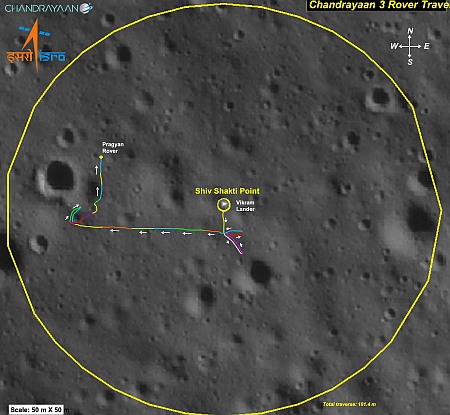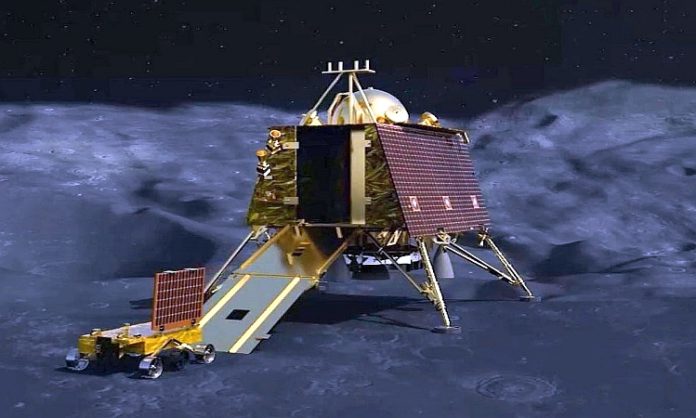Bengaluru: Pragyan rover, an integral part of the latest Moon mission, Chandrayaan-3, will be put in sleep mode to withstand massive dip in night temperature, said Indian Space Research Organisation (ISRO) on the day of launch of Aditya-L1 mission.
ISRO said on Saturday that Pragyan Rover has completed its work. It is now safely parked and set to sleep mode. Both the payloads APXS and LIBS onboard are now decommissioned. Data from these payloads has been transmitted to Earth through the lander.
Also Read: Chandrayaan’s rover finds many chemicals, search for hydrogen on
The battery is also fully charged. The rover has been placed in such a direction that when  the next sunrise occurs on the moon on September 22, 2023, sunlight falls on the solar panels. Its receiver has also been kept operational. It is expected that it will start working again on September 22.
the next sunrise occurs on the moon on September 22, 2023, sunlight falls on the solar panels. Its receiver has also been kept operational. It is expected that it will start working again on September 22.
Chandrayaan-3 mission is only for 14 days. This is because there is night for 14 days and light for 14 days on the Moon. Rover-lander can generate power in sunlight, but when night falls, the power generation process will stop. If there is no power generation, the electronics will not be able to withstand the severe cold and will get damaged.
Rover covered a distance of 100 meters
Earlier in the day, ISRO had informed that the rover has covered a distance of 100 meters from the Shivshakti landing point. A graph of the distance between the lander and the rover was also shared. Vikram Lander landed on the Moon on 23 August. The rover took 10 days to cover this distance.
Also Read: Chandrayaan-3: ISRO releases lander’s videos of Moon surface
The six-wheeled rover device weighs 26 kg. On Thursday morning, about 14 hours after landing, ISRO had confirmed the rover’s exit. The lander landed on the moon on August 23 at 6.40 pm. It moves at a speed of 1 cm per second.
Updates from Chandrayaan-3 till now
ILSA payload records earthquake on lunar surface: On August 31, ISRO said that the Instrument of Lunar Seismic Activity (ILSA) payload mounted on Chandrayaan-3’s Vikram lander has recorded the natural phenomenon of earthquake on the lunar surface. This earthquake came on 26 August. ISRO said that the probe into the source of the earthquake is going on.
LIBS payload confirmed sulphur on the Moon: The second observation sent on August 28 also revealed the presence of sulphur, aluminium, calcium, iron, chromium, titanium on the South Pole of the Moon. There are also manganese, silicon and oxygen on the surface, the search for hydrogen is ongoing.
Also Read: ISRO readies for Chandrayaan-3 landing; people seek divine blessing
Rover Pragyan changed the route after seeing a four-meter crater: On August 27, a 4 meter diameter crater came in front of the rover Pragyan. This crater was 3 meters ahead of the rover’s location. In such a situation, the rover was given the command to change the path. Even before this, Pragyan had passed through a small crater about 100 mm deep.
Plasma found on the surface, but less in density: The Radio Anatomy of Moon Bound Hypersensitive Ionosphere and Atmosphere-Langmuir Probe (RAMBHA-LP) mounted on the lander Vikram has discovered plasma on the South Pole of the Moon, although it is less dense (sparse).
Also Read: ISRO’s PSLV successfully places Aditya-L1 in outbound Earth orbit
First observation of Vikram Lander – Temperature around 50 degrees on the surface: ChaSTE payload mounted in Vikram Lander of Chandrayaan-3 has sent the first observation related to the temperature of the Moon. According to ChaSTE i.e. Lunar Surface Thermophysical Experiment, there is a lot of difference in the temperature on the surface of the Moon and at different depths.
The video of the rotation of Rover Vikram on the lunar surface has been made with the camera of Lander Vikram. ISRO shared it on August 31.
Also Read: ISRO’s PSLV successfully places Aditya-L1 in outbound Earth orbit
The video of the rotation of Rover Vikram on the lunar surface has been made with the camera of Lander Vikram. ISRO shared it on August 31.
Chandrayaan-3’s lander soft landing in 4 phases
ISRO started the automatic landing process on August 23 at 5.44 pm from an altitude of 30 km and completed the journey in the next 20 minutes.
Chandrayaan-3 orbited the Earth 21 times and the Moon 120 times in 40 days. Chandrayaan travelled 5.5 million km to cover a distance of 3.84 million km to the moon.
Also Read: SpaceX gets praise for ‘failed’ test flight of Starship
1. Rough Breaking Phase: The lander was 750 km away from the landing site. Altitude 30 Km and speed 6,000 Km/hr. This phase lasted for 11 and a half minutes. During this, the sensors of Vikram Lander were calibrated. The lander was brought to a horizontal position at a distance of 7.4 km from an altitude of 30 km.
2. Attitude Holding Phase: Vikram photographed the lunar surface and compared it with the already existing photos. At the time of Chandrayaan-2, this phase was of 38 seconds, this time it was reduced to 10 seconds. In 10 seconds, the height of Vikram Lander from the Moon decreased from 7.4 Km to 6.8 Km.
3. Fine Breaking Phase: This phase lasted for 175 seconds in which the speed of the lander became zero. The position of Vikram Lander was made completely vertical. Vikram Lander’s height from the surface remained about 1 kilometer
Also Read: Aditya-L1 is not a complete mission to study the Sun, says ISRO
4. Terminal Descent: In this phase, the lander was brought to a height of about 150 metres. When everything went well, a soft land was made on the surface of the Moon. This was India’s third mission to the moon, water was discovered in the first mission.
Missions on Moon
Chandrayaan-1 was launched in 2008. In this, a crash landing of a probe was done in which water was found on the moon. Then in 2019, Chandrayaan-2 reached close to the moon, but could not land. Chandrayaan-3 landed on the moon on 23 August 2023. Chandrayaan-3 also sent the message of reaching the moon safely. Said- ‘I have reached my destination.’




